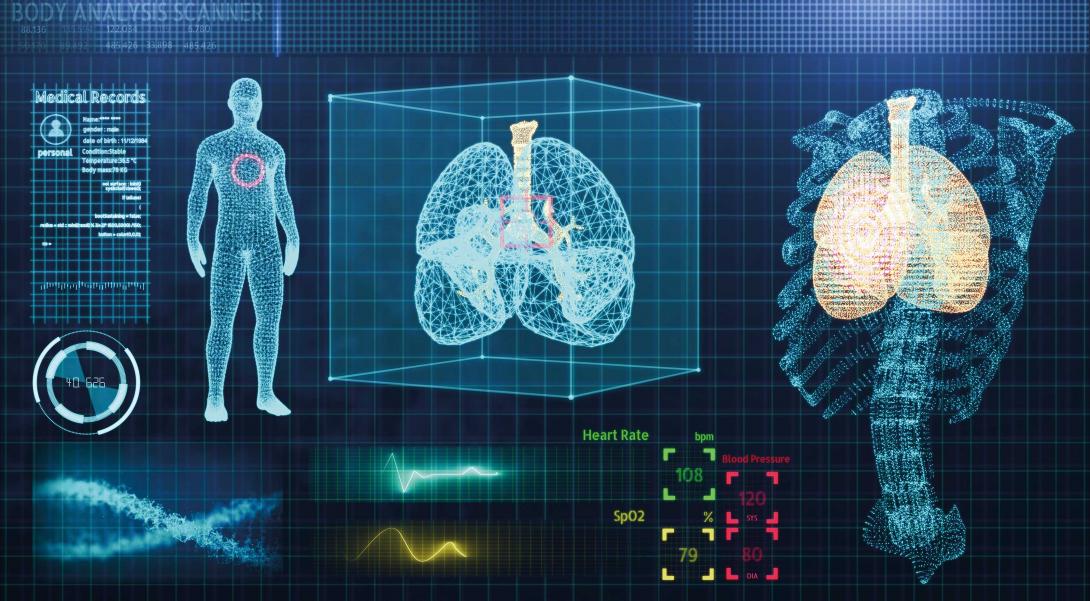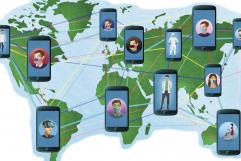
Teaching machines to think in order to move forward in the medicine of the future
The Artificial Intelligence and Machine Learning solutions are an opportunity for researchers and medicine professionals, alongside other technologies such as Big Data or augmented reality.
Artificial Intelligence and Machine Learning will be technologies that will revolutionise the medicine of the future. “There are more disruptive technologies such as blockchain or augmented reality, but the Machine Learning algorithms, which are part of Artificial Intelligence will be at the heart of this digital revolution,” Doctor Juanjo Beunza, a professor at the Faculty of Biomedical and Health Sciences at the Universidad Europea de Madrid and author of Manual práctico de Inteligencia Artificial en entornos sanitarias (A Practical Manual for Artificial intelligence in Healthcare Settings), along with Enrique Puertas and Emilia Condés.
In spite of the progress made in recent years, there is still a long way to go, since “some authors estimate that up to 85% of the AI projects fail. This is the same in the health sector,” Beunza defends. And this is because there is not enough practical technical knowledge, the expert observes. “There are many people with theoretical knowledge, who have studied a master in Big Data, for example, but not so many with practical experience,” he affirms. There is also “a very large gap between the technical knowledge and the field of applicability,” and “at times the emphasis is put on the application of a new technology and not on resolving a problem.”
For Doctor Beunza, “Often AI only provides 20% of the solution to a problem, although this 20% is very important. The spotlight must be on resolving a problem or enhancing a capacity and not on applying a deep neuronal network.” Because “often the best solution to a problem is a return to traditional logistics, particularly when the volume of data is not very large (which is very frequent in the Spanish healthcare setting)” he explains.
The challenges
And for this reason, according to the expert, “we need technical professions with knowledge and experience beyond that of Artificial Intelligence, instead of ultra-specialists with an in depth training and experience in a single, very specific tool.” In the healthcare setting, “professionals with more general training and experience are needed as we cannot have 200 engineers on the staff: we rarely have more than 2 or 3.”
“The speed at which technology changes is also a problem for its implementation,” the expert explains. Because “at times the solutions that we choose and implement become obsolete in the months it takes to obtain the approvals and certificates they require; therefore the commercial risk increases.” And another of the important problems is that “the wrong questions have usually been asked. The AI tools are generally very useful for highly specific tasks, for example, to estimate the Ejection Fraction in echocardiogram images, but they produce a large percentage of mistakes with generic, multiple tasks, such as carrying out paediatric diagnoses when substituting a paediatrician. And the wrong questions are usually asked because the development teams do not incorporate the physicians with knowledge of AI tools into their first phases. The valuable physicians have very little time and when they have it, they usually have important gaps in understanding these AI tools.”
Juanjo Beunza forms part of the Machine Learning Salud Group at the Universidad Europea, which was established two years ago to develop teaching experience and knowledge in the application of Artificial Intelligence tools in the health field. “It is an inter and trans- professional group,” he explains, “in which specialists from the technical area, such as computing engineering and biomedical engineering, etc collaborate, alongside health professionals. Professionals from the Hospital Universitario HLA Moncloa play a very important role in this group.”
Colaborative spirit
They have been working with predictive and diagnosis algorithms, both published and open source, with the aim of “Exploring the potentiality of these algorithms both in the classification of medical images, whether they are chest X-rays, MRI, blood smears, etc and in the training of predictive algorithms, for example, to predict cardiovascular events such as myocardial infarctions based on classic structured data. We start off with a collaborative, teaching spirit, therefore, we share all the knowledge that we develop with our students and our associates. On the other hand, we use open source hardware and software to ensure that a large number of people and institutions can benefit from this knowledge in a reasonable and sustainable way.”
The expert also started up the web site coRona-Ladies, a project born at a meeting of the R-Ladies Madrid, which seeks to promote the use of R programming amongst girls. “The project was aimed at creating a web site that compiled official data about the evolution of the Covid-19 pandemic to carry out useful epidemiological predictions for the management of materials and HR in the hospitals. However, we observed that the reliability of the data available was so inaccurate that the predictive models were basically useless. Therefore, we stopped the project,” Beunza acknowledges. “But it was a wonderful collaboration with R-Ladies and an important learning experience. We proved in situ that the quality of the algorithms is upheld by the quality of the data. Without data, everything else is useless.”
And what can AI applied to medicine do regarding Covid-19? A great deal. From diagnosis – remote clinics, automatic detection of temperature, analysis of chest X-rays, or of chest CTs, prediction – early detection of high risk of ICU requirement, material, logistical and HR needs, development of new drugs, the search for new molecules, recruitment for clinical trials, vaccines and control of cases in containment or mitigation, isolation, risk contacts, immune card. “But we must not forget that AI is a complement, an enhancer, not a solution,” Beunza insists. “I consider it a mistake to put the spotlight on the contact tracking tool, without having a sufficient number of trackers to carry it out. Or to have a voice diagnosis algorithm, without having a sufficient number of doctors and nurses in the health centres. AI is a tool, not a substitute for the professionals or the system.”
A lack of hybrid professionals
“One of the great problems we have is that the technical development teams have mastered the new technologies, but they have serious gaps when adapting the solutions that they develop to the reality of clinical settings,” Doctor Beunza affirms. “And the physicians who collaborate with them, often do not understand how these tools work, nor their limitations, possibilities or potential; therefore the dialogue is not fluid or efficient.” For the expert, there is a growing demand for professionals who can establish this dialogue between the needs of the professionals and the patients on the one hand and the technical possibilities of the proposed solutions on the other hand. “This is where careers such as biomedical engineering arise, or medicine professionals who get more in depth training on the artificial intelligence tools. But these new profiles are yet to be clearly defined or established.”
A historic change of cycle
“I think that we are living in exciting times for practicing and/or managing medicine,” Buenza affirms. “I consider that we are breaking a historic change of cycle. The healthcare system, as we know it, is not sustainable. And we must play the immense transformation opportunities available against the stress derived from the inefficiency of the current system,” he adds. Although the great difficulty, according to the expert, “is that we can no longer use patches. The entire system must be redesigned.”
For Doctor Beunza, “Above all, telemedicine and to a lesser extent, remote robotic surgery, will be essential in this new system where healthcare will be omnipresent. The patient will become the care centre and the number of in-person visits will be limited to the cases that are strictly necessary. And the explosion of remote sensors (already available at reasonable prices) will allow a large part of the examinations and operations that are currently done in-person, to be carried out remotely.”
Telemedicine and Covid-19
Telemedicine is one of the areas that has been favoured most by the Covid-19 pandemic and many projects have arisen in recent months. The digitalisation of society has moved forward between 3 and 5 years according to the experts, owing to the healthcare crisis. “Covid has been, and remains being, a drama, but it has forced us to use some of these tools that we already had available prior to Covid-19, such as telemedicine. We knew that at some point we had to start using them,” Beunza affirms. However, he acknowledges, “their use is not free from limitations. Let us think, for example, about the lack of legal cover that doctors have when making remote diagnoses, with all the risks that this entails. We have been forced to attend to our patients remotely, without being completely prepared for this, at times without the suitable equipment, or without any training. I consider this to be a painting that is full of light and shadows.”
The patients, with technology
“I think that the clinical care setting is a long way from having assimilated this revolution,” Beunza acknowledges. “We still make appointments with the specialist, so that after a more or less long wait, they give us test results that could be completely normal. We don’t say anything about the integration of all our clinical information with information from the hundreds of sensors that we have at our disposal with genetic, metabolic, analytical, imaging information etc… The privacy of the data is a very large stumbling block, but there are many proposals that allow us access, at least partially, to these tools with guarantees of safety and privacy. The transformation is underway, albeit very slowly.”
Wearable biosensors
There are other technologies and applications that can bring a great deal to medicine such as watches connected to mobile phones for epileptics, sugar meters for diabetics or smart shirts for hypertensive people, for example. “I think that biosensors are an essential element in telemedicine,” Doctor Beunza affirms. “A diagnosis cannot solely be based on the patient’s subjective information. If we want to carry out remote care and monitoring, we must lay down the foundations of these objective parameters, be they cardiac or respiratory frequency, O2 saturation or the noises from auscultation. And today we can build a device to obtain CF, RF and O2 Saturation for less than 15 €. Technology and its costs are already assumable by the immense majority of the Spanish population. We need access to this knowledge and to implant it.”




